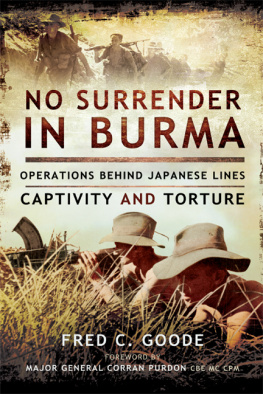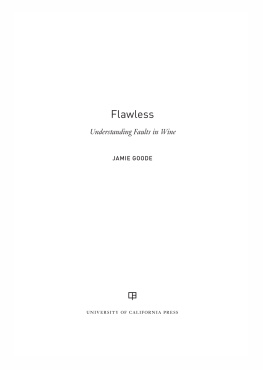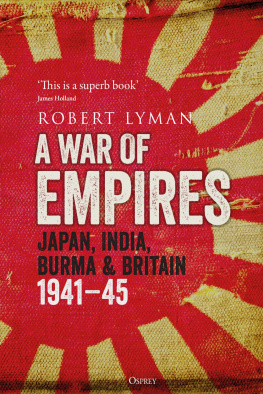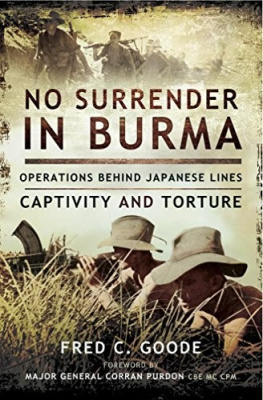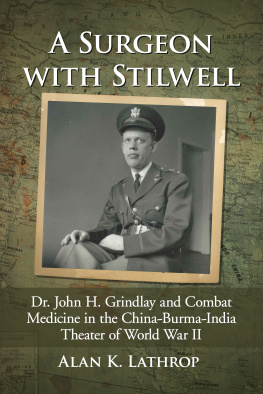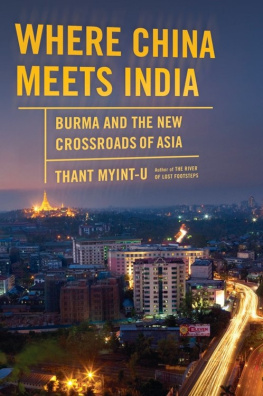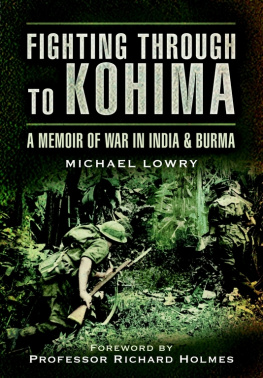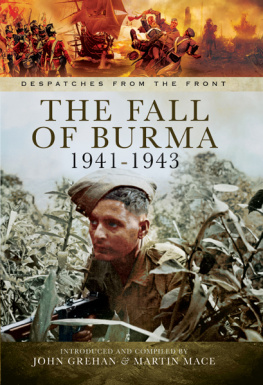
First published in Great Britain in 2014 by
Pen & Sword Military
an imprint of
Pen & Sword Books Ltd
47 Church Street
Barnsley
South Yorkshire
S70 2AS
Copyright Peter Frederick Goode 2014
ISBN 978 1 47382 378 5
eISBN 9781473840966
The right of Peter Frederick Goode to be identified as the Author of this Work has been asserted by him in accordance with the Copyright, Designs and Patents Act 1988.
A CIP catalogue record for this book is available from the British Library
All rights reserved. No part of this book may be reproduced or transmitted in any form or by any means, electronic or mechanical including photocopying, recording or by any information storage and retrieval system, without permission from the Publisher in writing.
Typeset in Ehrhardt by
Mac Style Ltd, Bridlington, East Yorkshire
Printed and bound in the UK by CPI Group (UK) Ltd, Croydon, CRO 4YY
Pen & Sword Books Ltd incorporates the imprints of Pen & Sword
Archaeology, Atlas, Aviation, Battleground, Discovery, Family
History, History, Maritime, Military, Naval, Politics, Railways, Select,
Transport, True Crime, and Fiction, Frontline Books, Leo Cooper,
Praetorian Press, Seaforth Publishing and Wharncliffe.
For a complete list of Pen & Sword titles please contact
PEN & SWORD BOOKS LIMITED
47 Church Street, Barnsley, South Yorkshire, S70 2AS, England
E-mail: enquiries@pen-and-sword.co.uk
Website: www.pen-and-sword.co.uk
Contents
Acknowledgements
by Peter F. Goode
T here are many people to whom I would like to offer my gratitude, not least my wife Yayoi Faith, a Japanese national who transcribed my fathers notes onto disk and translated Japanese Kanji documents, and who through it all has been patient, enthusiastic and courageous in reading of the atrocities committed by Japanese forces during the occupation of Burma. Stephen Fogden is by far the leading expert on the POWs held in Rangoon Central Jail, and his contribution of sharing documents with me is greatly appreciated. With him I was able to identify many characters from my fathers notes. Nick Collins of the Commando Veterans Association was kind enough to post on their website (http://www.commandoveterans.org/site) a brief resume of my father and SSDII, a post to which we received many responses and links, one of which was from Alan Weeks, of the Swythamley Historical Society in Staffordshire, who is researching the history of the Brocklehurst Estate. To Alan, too, I am very grateful for support and assistance in my research. Michael Rawlinson, a fellow retired Hong Kong Police officer with whom I had the pleasure of working on many complicated cases during our long careers was an inspiration when it came to historical research and review of the draft. Finally I would like to thank Patrick Newman for his help, advice and tremendous encouragement.
Having made these acknowledgements, I would like to point out that the story told here is my fathers own, and I have made no attempt to alter it in any way. It is also not a historical account of my fathers unit, which basically was in existence from September 1941 to July 1942. It is one mans story of personal survival against all odds.
Foreword
by Major General Corran Purdon CBE MC CPM
T his is a gripping, true account by a Commando during the Burma campaign. He and the members of his Commando were sent from the Middle East to assist Chiang-Kai-Shek in his guerilla war against the Japanese.
On arrival in Burma the Commandos were posted to the Bush Warfare School at Maymyo. Here they were instructed in how to live in the jungle by local Burmans, in the use of explosives by the famous, later Brigadier, Mike Calvert DSO, and in the rudiments of Urdu and Mandarin. Frederick Goode alone of his comrades was very successful in learning these languages, which knowledge was to prove vital in the future. The Commandos carried out attacks against Thai/Japanese positions, but were eventually cut off behind the Japanese lines. Their CO decided that he and his Commando should split into small groups and make their way towards India and safety.
Frederick walked 2,000 miles towards India, but was betrayed to the Japanese when only twenty miles short of his destination. They were captured, tortured and held in Rangoon Central Jail until the end of the war.
This forceful and vivid account is compelling reading and should be among the epics of the Burma Campaign. Frederick Goode was a Corporal at the time and had his deeds and powers of leadership been officially known then he could well have been decorated and commissioned.
Introduction
by Peter F. Goode
F rederick Charles Goode was born in Birmingham, England on 22 July 1918, one of nine children of Gertrude and William Goode in the Lozells district of the city. He was educated locally until the age of 14, and worked as a labourer until the age of 17, when he joined the 1st Battalion, The Duke of Cornwalls Light Infantry, as a private with the army number 5108868. Freds first posting overseas was to Lahore, then still part of India. With the outbreak of war in 1939 his regiment was sent to Libya and based in Tobruk, where it saw action against German and Italian forces. When the British Army then called for volunteers for Commando units in late 1940 he joined No. 8 Commando, and after initial training in the UK arrived at the Bush Warfare School in Maymyo (now Pyin Oo Lwin), in the Shan Highlands of Burma, some forty miles east of Mandalay, in September 1941.
The school was set up in early 1941 following the success of a similar school established at Wilsons Promontory, Victoria, Australia, to train elements of the Australian Army Independent Companies (AAIC), by Mike Calvert, DSO (and Bar), also known as Mad Mike Calvert, and Colonel F. Spencer Chapman, DSO. After training Commando detachments in demolition techniques there and in Hong Kong, Calvert commanded the school at Maymyo, while Chapman was posted to a similar school in Singapore. Elements of the AAIC were already in Maymyo when the British contingent some 100 men, including Fred arrived. The new arrivals were assigned to two newly formed units: Special Service Detachment I (Middle East), or SSDI, and Special Service Detachment II (Middle East), or SSDII. Fred was one of the fifty men assigned to the latter.
SSDI was initially led by Orde Wingate, then a captain, but subsequently was commanded by Major Milman. SSDII was commanded from the outset by Henry C. Brocklehurst, initially a captain, then a major, then finally a lieutenant colonel.
SSDI and SSDII were set up under the codename Mission 204, also known as Tulip Force, their mission being, alongside elements of the AAIC, to secretly go into China and train Chinese troops in demolition and guerilla tactics to use against the occupying Japanese. However, following the Japanese attack on Pearl Harbor on 7 December 1941, the two units orders were changed, and they were directed to assist in the defence of Burma, with SSDII assigned to the 1st Burma Division. In early February 1942 the C-in-C West Pacific Earl Wavell ordered that Orde Wingate co-ordinate irregular warfare in the theatre. SSDI and SSDII therefore came under the direct command of Wingate, now a Brigadier.
SSDI were deployed to Loimwe in Shan, and SSDII to the Taunggyi area of the state. The majority of SSDI eventually crossed the Irrawaddy River into India and safety. Milman was then assigned to Kunming. The same, sadly, was not true for the men of SSDII, who reached the Irrawaddy at Shwegu in February 1942 to find the far bank swarming with Japanese.

